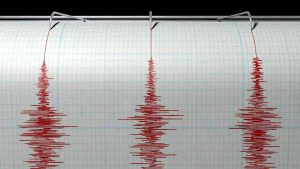
A striking finding of the 2011 Tohoku-oki earthquake (Mw 9.0) is that more than 50 meters of coseismic fault slip reached the trench axis. In addition to this, seismological studies found a clear depth-dependent variation in the source location between high- and low-frequency seismic energy radiation. However, structural features that may control the slip behavior in the rupture zone have not been well examined.
In their article for Geosphere, authors Shuichi Kodaira and colleagues processed seismic reflection data acquired in the rupture zone by a Japanese research vessel Kairei and examined depth-varying structural characteristics. The resultant characteristic structures were a frontal prism, which is a wedge-shaped sedimentary unit at the trench-ward tip of the overriding plate, a reflective zone at the seaward end of the coherent continental framework above subducted oceanic crust, and subducted horst-and-graben structures that could be traced down to ~25 km depth.
Kodaira and colleagues considered the size and distribution of the frontal prism together with data from a previous study and found that the frontal prism along the Japan Trench is well-developed from central to the northern end of the Japan Trench.
The association of the frontal prism and the large slip zone of the 2011 Tohoku-oki earthquake as well as the fault zone of the 1896 Sanriku earthquake indicates that tsunami earthquakes with large shallow slip have occurred where the frontal prism is well developed. Clear horst-and-graben structures, which were formed due to bending the oceanic plate at a subduction zone, were imaged beneath the frontal prism and the reflective zone. These images show that the throws of the normal faults associated with the horst-and-graben structures are larger by up to ~2 km beneath the reflective zone. This indicates continuous bending of the plate even after the oceanic plate is subducted.
By considering seismic images and seismicity observed by both on-land and ocean-bottom seismograph networks, Kodaira and colleagues identified the following depth-varying structural features: The shallow part of the rupture zone, where tsunami earthquakes occur, is characterized by low levels of short-period seismic energy radiation, a well-developed low-velocity frontal prism and reflective zone, and low seismicity along the plate interface. In the rupture zone from the reflective zone to 25 km deep, where large coseismic slips with low levels of short-period seismic energy are observed, subducted horst-and-graben structures are imaged and background seismicity along the plate interface is very low. In the rupture zone deeper than 25 km, clear seismic images were not obtained, but high landward-dipping background seismicity was observed. This is interpreted that the plate interface at this depth is characterized by high background seismicity.
Reference:
Shuichi Kodaira et al. Depth-varying structural characters in the rupture zone of the 2011 Tohoku-oki earthquake, Geosphere (2017). DOI: 10.1130/GES01489.1
Note: The above post is reprinted from materials provided by Geological Society of America.










